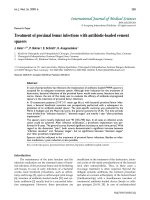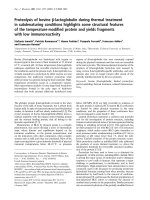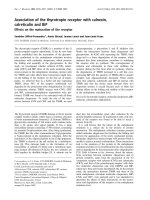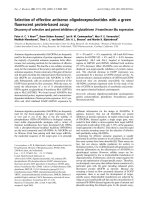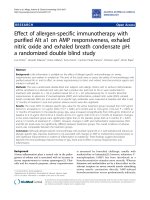Báo cáo y học: "Efficacy of Sirolimus-Eluting Stents Compared With Paclitaxel-Eluting Stents in an Unselected Population With Coronary Artery Disease: 24-Month Outcomes of Patients in a Prospective Non-randomized Registry in Southern Turkey&
Bạn đang xem bản rút gọn của tài liệu. Xem và tải ngay bản đầy đủ của tài liệu tại đây (215.68 KB, 6 trang )
Int. J. Med. Sci. 2010, 7
191
I
I
n
n
t
t
e
e
r
r
n
n
a
a
t
t
i
i
o
o
n
n
a
a
l
l
J
J
o
o
u
u
r
r
n
n
a
a
l
l
o
o
f
f
M
M
e
e
d
d
i
i
c
c
a
a
l
l
S
S
c
c
i
i
e
e
n
n
c
c
e
e
s
s
2010; 7(4):191-196
© Ivyspring International Publisher. All rights reserved
Research Paper
Efficacy of Sirolimus-Eluting Stents Compared With Paclitaxel-Eluting
Stents in an Unselected Population With Coronary Artery Disease: 24-Month
Outcomes of Patients in a Prospective Non-randomized Registry in South-
ern Turkey
Davran Çiçek
1
, Hasan Pekdemir
2
, Nihat Kalay
3
, Süleyman Binici
4
, Hakan Altay
4
, Haldun Müderrisoğlu
5
1. Başkent University School of Medicine, Department of Cardiology, Antalya, Turkey;
2. İnönü University School of Medicine, Department of Cardiology, Malatya, Turkey;
3. Erciyes University School of Medicine, Department of Cardiology, Kayseri, Turkey;
4. Başkent University School of Medicine, Department of Cardiology, Adana, Turkey;
5. Başkent University School of Medicine, Department of Cardiology, Ankara, Turkey
Corresponding author: Davran Cicek, Başkent University School of Medicine, Department of Cardiology,
Alanya/Antalya/Turkey, Tel: +90 532 3336466, Fax: +902425115563. E-mail:
Received: 2010.04.27; Accepted: 2010.06.04; Published: 2010.06.10
Abstract
Background: The efficacy of drug-eluting stents has been shown in randomized trials, but
some controversy exists regarding which stent sirolimus-eluting or paclitaxel-eluting is more
effective in unselected Turkish patients. Therefore, we investigated the clinical outcomes of
patients who were treated with one type of these drug-eluting stents in the real world.
Methods: We created a registry and prospectively analyzed data on a consecutive series of
all patients who presented to our institution with symptomatic coronary artery disease
between February 2005 and March 2007 and who were treated with the sirolimus- or the
paclitaxel-eluting stent. The follow-up period after stent implantation was approximately 24
months. The primary end point was a major cardiac event, and the secondary end point was
stent thrombosis. Informed consent was obtained from all subjects, and the study protocol
was approved by the local ethical committee.
Results: In total, 204 patients were treated with either the sirolimus-eluting stent (n = 103)
or the paclitaxel-eluting stent (n = 101). The lesions in the 2 arms of the study were treated
similarly by conventional technique. At 24-month follow-up, patients who received the pac-
litaxel-eluting stent showed significantly higher rates of non–Q-wave myocardial infarction
(1.9% vs 5.9%; P: .002), target vessel revascularization (1.9% vs 4.9%; P: .002), coronary artery
bypass graft surgery (1.9% vs 6.9%; P: .001), and late stent thrombosis (1.9% vs 3.9%, P: .002).
Conclusions: Patients who received the sirolimus-eluting stent showed better clinical
outcomes compared with those who had the paclitaxel-eluting-stent.
Key words: coronary artery disease, drug-eluting stent, major adverse cardiac event, stent throm-
bosis.
INTRODUCTION
Because of their association with decreased in-
cidents of restenosis and repeat intervention, the siro-
limus-eluting stent (SES)
1
and the paclitaxel-eluting
stent (PES)
2
have been shown to be superior to the
bare-metal stent. Along with the accumulation of
clinical experiences, drug-eluting stents increasingly
have been used for more complex lesions involving
the left main coronary artery,
3
in-stent restenosis,
4
Int. J. Med. Sci. 2010, 7
192
chronic total occlusion,
5
and acute myocardial infarc-
tion.
6
Although several head-to-head analyses of the
SES and the PES have been published in the medical
literature, uncertainty remains regarding whether a
true difference in clinical outcomes exists. The ran-
domized, multicenter REALITY trial
7
did not demon-
strate a difference in clinical outcomes between pa-
tients who received the SES and those who received
the PES. This finding has been supported by large
registries.
8,9
In contrast, a number of smaller rando-
mized studies have shown differences in end points,
confirmed both angiographically and clinically, in
favor of the SES.
10-13
Furthermore, in meta-analyses of
studies comparing the 2 stent types, authors have
confirmed a clinical advantage for those who receive
the SES.
14–17
However, the long-term safety of
drug-eluting stents has been questioned.
17-19
Despite
the results of meta-analyses of randomized studies
that refute these concerns,
20
the possible association of
the stents with late stent thrombosis remains a limita-
tion of this new technology. The long-term outcomes
of Turkish patients treated with the SES vs the PES in
real-world practice are not well reported. Therefore,
we report the 24-month outcomes of unselected pa-
tients in southern Turkey who had coronary artery
disease that was treated with either the SES or the
PES.
METHODS
Patient Population
The study population consisted of 204 consecu-
tive series of all patients who had undergone coronary
stent implantation for coronary artery disease be-
tween February 2005 and March 2007; 103 of the pa-
tients received the SES (CYPHER; Cordis Corpora-
tion, Johnson and Johnson, Miami Lakes, Florida), and
the other 101 patients received the PES (TAXUS, Bos-
ton Scientific, Natick, Massachusetts). Patients were
eligible for enrollment if there was symptomatic co-
ronary artery disease or positive functional testing,
and angiographic evidence of a target lesion stenosis
of ≥ 70% in a ≥ 2-mm vessel. Patients with a contrain-
dication to antithrombotic therapy were excluded
from the study. The coronary angiograms were ob-
tained when there was evidence of ischemia. The fol-
low-up period was approximately 24 months. In-
formed consent was obtained from all subjects, and
the study protocol was approved by the local ethical
committee.
Medications and Percutaneous Coronary Inter-
vention Procedure
All patients were pretreated with aspirin and
clopidogrel. A loading dose of 300 mg of clopidogrel
was administered before the procedure for those who
were not pretreated. During the procedure, a bolus
dose of unfractionated heparin (100 U/kg) was in-
jected through a femoral or radial artery sheath, with
a bolus repeated as needed to maintain an activated
clotting time of 250 to 300 seconds. Patients received
intracoronary nitroglycerin (0.1 to 0.2 mg) before ini-
tial and final angiograms to achieve maximal vasodi-
latation. The use of glycoprotein IIb/IIIa inhibitor
(Tirofiban) was at the operator’s discretion. All pa-
tients maintained antiplatelet therapy after the pro-
cedure (aspirin 300 mg/d for 3 months, then 100
mg/d infinitely; clopidogrel 75 mg/d for 6 to 12
months). The percutaneous coronary intervention
procedure and stent implantation were performed
using standard methods, through a femoral or radial
approach. The operators were free to use the stent
approach and the stent (ie, SES or PES) that they con-
sidered better.
Study End Points and Definitions
The primary clinical end points were major ad-
verse cardiac events (MACE), including cardiac death,
myocardial infarction (MI), and target vessel revas-
cularization (TVR). MI was defined as the elevation of
creatine kinase (CK) > 2 times above the upper limit of
normal with any associated elevation in the CK myo-
cardial band or the development of new pathologic Q
waves in 2 contiguous electrocardiographic leads.
TVR was defined as either percutaneous or surgical
revascularization (CABG) of the stented epicardial
vessel. The secondary end point was stent thrombosis
(ST) (ie, acute, < 1 day; subacute, 1 to 30 days; late, ≥
30 days; and very late, ≥1 year). For the assigned
study stent, device success was defined as ≤ 50% di-
ameter stenosis of the target lesion, and procedure
success was defined as device success with no
in-hospital MACE. The definitions of MI and ST used
in this study were consistent with the newest con-
sensus of the Academic Research Consortium.
21
All
primary and secondary clinical end points were ad-
judicated by an independent clinical events commit-
tee blinded to the patient’s treatment assignment.
Follow-up
Clinical follow-up was performed at 1, 6, 12, and
24 months by telephone contact or office visit. Rele-
vant data were collected and entered into a compute-
rized database by specialized personnel at the cardi-
ovascular interventional heart center.
Statistical Analysis
All statistical analyses were performed with
SPSS for Windows (version 10.0, Chicago, USA).
Continuous variables were described as mean (SD),
Int. J. Med. Sci. 2010, 7
193
and categorical variables were reported as percen-
tages or proportions. Comparison of continuous va-
riables was performed with unpaired t tests (normal
distribution) and the nonparametric Mann-Whitney
test (skew distribution). Analysis of categorical va-
riables was made with Fisher’s exact test and χ
2
test.
We used Kaplan-Meier time-to-event estimates for the
primary events at 24-month follow-up. With the
Kaplan-Meier method and log-rank test, we com-
pared the difference between the SES and PES co-
horts. A P value < 0.05 was considered statistically
significant.
RESULTS
Baseline clinical, angiographic, and lesion cha-
racteristics are shown in Tables 1 and 2. The baseline
clinical or demographic characteristics indicated no
statistically significant differences between patients
who received the SES vs those who received the PES.
Baseline angiographic characteristics were also simi-
lar according to the modified ACC/AHA (American
College of Cardiology/American Heart Association)
classification.
22
Overall, most lesions were located in
the left anterior descending artery and were types B1
or C. The mean stent diameter was 30 (SD, 4) mm
among those who received the SES and 31 (SD, 5) mm
(P:.4) among those who received the PES (Table 2).
The mean stent length was 26 (SD, 7) mm in the SES
cohort and 28 (SD, 8) mm (P:0.3) in the PES cohort.
In-Hospital Outcomes
In-hospital outcomes were similar between the 2
cohorts. In-hospital incidence of MACE was 1.9% for
patients receiving the SES and 1.9% in patients re-
ceiving the PES (P: .8).
Long-term Clinical Outcomes
Complete clinical follow-up at 24 months was
accomplished for 199 patients. The outcomes are re-
ported in Table 3. At 24 months, the incidence of
MACE was 9.7% in the SES cohort and 17.8% in the
PES cohort (P:.04). The incidence of coronary artery
bypass graft procedures (1.9% vs 6.9%; P:.001), TVR
(1.9% vs 4.9%; P: .002), and non–Q-wave MI (1.9% vs
5.9%; P:.002) was significantly higher in the PES co-
hort. There were no major differences in the rates of
death (1.9% vs 0.9%; P: .307), Q-wave MI (3.8% vs
5.9%; P: .326), and non–TVR (1.9% vs 3.9%; P: .3). As
reported in Table 4, the incidence of late ST at 24
months was significantly higher in the PES cohort
(1.9% vs 3.9%; P:.002). Between the SES and PES co-
horts, no major differences existed in the incidence of
acute (0.9% vs 0.9%; P:1.1) and subacute (0.9% vs
3.9%; P:.08) ST.
Table 1. Age and Baseline Clinical Characteristics of Patients by Treatment Cohort
Characteristic Sirolimus
a
(n = 103)
Paclitaxel
b
(n = 101)
P Value
c
Age, mean (SD), y
c
57 (10.9) 58 (10.2) .9
History, No. (%)
Diabetes mellitus 40 (39) 36 (36) .5
Hypertension 62 (60) 64 (63) .5
History of smoking 72 (70) 55 (54) .08
Hyperlipidemia 67 (65) 69 (68) .8
Prior MI 11 (11) 7 (7) .1
Prior PTCA 9 (9) 6 (6) .6
Prior CABG 8 (8) 3 (3) .2
SAP 29 (28) 34 (34) .2
USAP 59 (57) 47 (47) .08
MI 15 (15) 20 (20) .3
Serum concentrations, mean (SD), mg/dL
Total cholesterol 214.5 (63.6) 233.8 (57.4) .7
LDL 145.5 (52.3) 150.3 (48.4) .5
HDL 38.4 (6.2) 39.4 (8.3) .7
Triglyceride 161.1 (95.4) 158.6 (101.2) .6
Glucose 141.3 (67.3) 114.7 (46.4) .06
Abbreviations: CABG, coronary artery bypass graft; HDL, high-density lipoprotein; LDL, low-density lipoprotein; MI, myocardial infarc-
tion; SAP, stable angina pectoris; USAP, unstable angina pectoris.
a
Indicates patients who received sirolimus-eluting stents. Numbers in the column do not total 100% because some patients had more than
one condition.
b
Indicates patients who received paclitaxel-eluting stents. Numbers in the column do not total 100% because some patients had more than
one condition.
c
P < 0.05 defined as statistically significant.
Int. J. Med. Sci. 2010, 7
194
Table 2. Baseline Angiographic Characteristics
Characteristic Sirolimus
a
(n = 103)
Paclitaxel
b
(n = 101)
P Value
c
Site of Lesion Treated, No. (%)
LAD 74 (72) 76 (75) .7
Cx 12 (12) 9 (9) .5
RCA 17 (17) 16 (16) .9
LVEF
d,e
68.3 (6.1) 67.4 (7.3) .9
Stent diameter, mm
e
30 (4) 31 (5) .4
Stent length, mm
e
26 (7) 28 (8) .3
Lesion length, mm
e
21 (6) 22 (7) .4
Type of lesion, No. (%)
A 0 (0) 2 (1.9) .3
B1 46 (45) 47 (47) .9
B2 15 (14) 11 (11) .6
C 42 (41) 41 (41) .8
Abbreviations: Cx, left circumflex coronary artery; LAD, left anterior descending coronary artery; LVEF, left ventricular ejection fraction;
RCA, right coronary artery.
a
Indicates patients who received sirolimus-eluting stents.
b
Indicates patients who received paclitaxel-eluting stents.
c
P < 0.05 defined as statistically significant.
d
Reported as percentage.
e
Data expressed as mean (SD).
Table 3. Clinical Outcomes at 24-Month Follow-up
Outcome Sirolimus
a
[No. (%)]
Paclitaxel
b
[No. (%)]
P Value
c
MACE 10 (9.7)
d
18 (17.8) .04
Death 2 (1.9) 1 (0.9) .307
Myocardial infarction
Q-wave 4 (3.8) 6 (5.9) .326
Non–Q-wave 2 (1.9) 6 (5.9) .002
Revascularization
Target vessel 2 (1.9) 5 (4.9) .002
Non–target vessel 2 (1.9) 4 (3.9) .3
CABG surgery 2 (1.9) 7 (6.9) .001
Abbreviations: CABG, Coronary artery bypass graft; MACE, Major adverse cardiac event (ie, death, myocardial infarction, and target vessel
revascularization.
a
Indicates patients who received sirolimus-eluting stents. Percentages in this column are based on a cohort of 103 patients.
b
Indicates patients who received paclitaxel-eluting stents. Percentages in this column are based on a cohort of 101 patients.
c
P < 0.05 defined as statistically significant.
Table 4. Comparison of Secondary End Points by Cohort
Type of Stent Thrombosis Sirolimus
a
[No. (%)]
Paclitaxel
b
[No. (%)]
P Value
c
Acute 1 (0.9) 1 (0.9) 1.1
Subacute 1 (0.9) 4 (3.9) .08
Late 2 (1.9) 4 (3.9) .002
Very late 0 (0) 1 (0.9) .09
a
Indicates patients who received sirolimus-eluting stents. Percentages in this column are based on a cohort of 103 patients.
b
Indicates patients who received paclitaxel-eluting stents. Percentages in this column are based on a cohort of 101 patients.
c
P < 0.05 defined as statistically significant.
Int. J. Med. Sci. 2010, 7
195
Discussion
The major finding in the present study is that the
SES was associated with better long-term safety and
efficacy than the PES in unselected Turkish patients
with coronary artery disease. However, despite our
study and several others in which the SES and the PES
have been compared, uncertainty still remains re-
garding whether any real difference in clinical out-
comes exists. Ong and colleagues
8
recently compared
the results of 2 registries SES-based RESEARCH (Ra-
pamycin-Eluting Stent Evaluated at Rotterdam Car-
diology Hospital) and PES-based T-SEARCH (Tax-
us-Stent Evaluated at Rotterdam Cardiology Hospit-
al) and showed similar adjusted clinical outcomes for
patients who received the PES compared with those
who received the SES. The authors suggested that the
inferior trend in crude outcome observed for PES re-
cipients in other studies can be attributed to the
higher risk profiles of these patients. Two randomized
trials comparing the SES and the PES head to head
have been published recently.
7,10
Each trial equally
showed better angiographic parameters for patients
who received the SES vs those who received the PES,
but regarding clinical outcomes and binary restenosis
rates, they showed controversial results. In the
REALITY trial,
7
patients who had MI, ostial lesions,
in-stent restenosis, or chronic total occlusion lesions
were excluded, and there was no significant differ-
ence between the 2 types of stents in clinical outcomes
and binary restenosis. However, in the SIRTAX trial,
10
all comers were enrolled and over 9 months, patients
treated with the PES showed higher rates of MACE
and binary restenosis rates than those treated with the
SES. The superiority of the SES over the PES in clinical
outcomes resulted mainly from differences in rates of
target lesion revascularization; SES use did not de-
crease death and MI rates. Moreover, meta-analysis
results showed that patients receiving the SES had a
significantly lower risk of restenosis and TVR com-
pared with those receiving the PES and suggested that
SES use may result in better outcomes in relatively
complex lesions and high-risk patients.
14
In our study, no differences existed in baseline
clinical and angiographic characteristics between
those who received the SES and those who received
the PES. The SES was associated with better clinical
outcomes compared with the PES; rates of MACE
were 9.7% vs 17.8% (P:.04). The superiority of the SES
over the PES in clinical outcomes resulted mainly
from differences in rates of late ST and target lesion
revascularization. The incidence of late ST was sig-
nificantly higher at 24 months for PES recipients. No
major differences existed in the incidence of acute and
subacute ST between SES recipients and PES reci-
pients. In the PES cohort, the incidence of TVR was
significantly higher due to ST.
Seven patients in the
PES cohort and 4 patients in SES cohort were prema-
turely taken off klopidogrel therapy, and this change
likely played a role in the MACE events observed in
the PES and SES cohort. Of those continuing dual
antiplatelet therapy, 96% were in the SES cohort, and
93% were in the PES cohort. And the difference be-
tween PES and SES groups seems to be associated
with much number of patients prematurely taken off
klopidogrel in PES group.
PES treatment still was associated with poor
overall clinical outcomes compared with outcomes
associated with SES treatment. Also, in the multiva-
riate analysis, after adjusting for clinical variables, we
found that PES use was a predictor of MACE within
24 months. Given that our patients tend to have
high-risk profiles (eg, type C lesions, 41%; type Bı
lesions, 45%; mean [SD] lesion length, 21 [6] mm;
hypertension, 62%; diabetes mellitus, 37%; hyperli-
pidemia, 67%; and acute MI, 17%), our results cor-
respond with those of previous randomized studies in
which relatively high-risk patients showed better
clinical outcomes after SES use.
10, 14, 21
Study Limitations
The study has several limitations—mainly, the
small number of patients, lack of direct randomiza-
tion, and relatively low compliance with angiographic
follow-up.
CONCLUSIONS
On the basis of the clinical results of this
24-month study, one might reasonably conclude that
treating with a sirolimus-eluting stent is more effec-
tive than treating with a paclitaxel-eluting stent in
Turkish patients.
Acknowledgments
All support for this study came from institution-
al and departmental resources.
Abbreviations
ACC: American College of Cardiology; AHA:
American Heart Association; CABG: coronary artery
binding graft; CK: creatine kinase; MACE: major ad-
verse cardiac events; MI: myocardial infarction; PES:
paclitaxel-eluting stent; RESEARCH: Rapamy-
cin-Eluting Stent Evaluated at Rotterdam Cardiology
Hospital; SES: sirolimus-eluting stent; ST: stent
thrombosis; T-SEARCH: Taxus-Stent Evaluated at
Rotterdam Cardiology Hospital; TVR: target vessel
revascularization.



